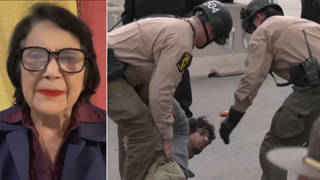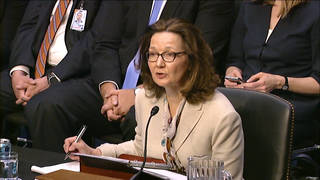
Guests
- Nathaniel Raymonddirector of the Campaign Against Torture at Physicians for Human Rights and the lead author of the new report 'Experiments in Torture: Evidence of Human Subject Research and Experimentation in the Enhanced Interrogation Program'
- Dr. Allen Kellerdirector of the Bellevue/NYU Program for Survivors of Torture and an associate professor of medicine at the NYU School of Medicine. He is a co-author of the Physicians for Human Rights report “Experiments with Torture.”
A new report from Physicians for Human Rights accuses the Bush administration of conducting illegal and unethical human experimentation and research on prisoners in CIA custody. The report details how doctors, psychologists and other professionals monitored the effects of sleep deprivation, waterboarding and other so-called “enhanced interrogation” techniques on more than a dozen prisoners. It charges that CIA doctors and other medical personnel turned the prisoners into research subjects and collected data in order to study and refine those techniques, but did so under the guise of trying to protect the health of the detainees. [includes rush transcript]
Transcript
AMY GOODMAN: A new report from Physicians for Human Rights accuses the Bush administration of conducting illegal and unethical human experimentation and research on prisoners in CIA custody. The report details how doctors, psychologists and other professionals monitored the effects of sleep deprivation, waterboarding and other so-called “enhanced interrogation” techniques on more than a dozen prisoners. It charges that CIA doctors and other medical personnel turned the prisoners into research subjects and collected data in order to study and refine those techniques, but did so under the guise of trying to protect the health of the detainees. The report argues that in determining how far a harsh interrogation could go, doctors, psychologists and physician’s assistants participated in justifying acts that had long been classified illegal, provided legal cover against prosecution, and helped designed future interrogation procedures.
CIA officials have rejected the conclusions of the report. Agency spokesman Paul Gimigliano said in a statement, quote, “The report is just wrong…The CIA did not, as part of its past detention program, conduct human subject research on any detainee or group of detainees.”
Well, the report is called “Experiments in Torture: Evidence of Human Subject Research and Experimentation in the 'Enhanced Interrogation' Program.” I’m joined now by two of the report’s authors: in Boston, Nathaniel Raymond, director of the Campaign Against Torture at Physicians for Human Rights and lead author of the new report; and here in New York, Dr. Allen Keller, the director of the Bellevue/NYU Program for Survivors of Torture. He’s an associate professor of medicine at NYU School of Medicine.
We welcome you both to Democracy Now! We’re going to begin with Nathaniel Raymond. Lay out the report and respond to the CIA spokesperson.
NATHANIEL RAYMOND: Well, Amy, our response to the CIA is simply this: we’ve shown our evidence to the world; it’s time that they show us theirs. And our report is very clear about its limitations. It’s based on heavily redacted public documents that were declassified over the past year. But what’s clear, even despite the blackouts in the documents, is that there are three instances in the Bradbury Office of Legal Counsel memo which we have concluded — and we stand by this conclusion — can constitute human subject research and experimentation in contravention of both the Nuremberg code and US domestic law.
Those three instances, which you touched on earlier, include a passage where CIA physicians and other personnel appear to be monitoring the difference between applying tactics individually and sequentially to detainees and applying tactics in combination. And there’s a conclusion based on the observation that was occurring by health professionals that the tactics would not behave or cause increased susceptibility to severe pain when used in combination. And as Physicians for Human Rights, we have made the clinical conclusion that this can constitute evidence of human subject research and experimentation, because of data collection, the application of that data to generalizable knowledge, and then the use of that generalizable knowledge to inform policy and procedure. And that’s what we see happening in three instances in declassified documents.
AMY GOODMAN: And explain a little more those three instances.
NATHANIEL RAYMOND: A second instance we document is the use of saline, as opposed to water, in waterboarding. We see a meticulous collection of data related to waterboarding. And that data is used, it appears, to inform basically how the CIA took the tactic from what we call the SERE technique — the Survival, Evasion, Resistance, Escape military training program — and basically reversed-engineer then to what we call waterboarding 2.0. And in the attempt to, quote, “make the tactics safe, legal and effective,” it appears that the inevitable outcome of using health professionals to attempt to take inevitably harmful tactics and, quote-unquote, to “sanitize” them or make them safe means applying medical knowledge in ways that would never have been clinically allowed. And one of those examples, which I mentioned a moment ago, the use of saline in waterboarding, was ostensibly to prevent hyponatremia, a sodium deficiency that can come from large volumes of fresh water being ingested. That is not only unethical and illegal, it makes a mockery of the core foundations of the healing arts, which are about doing no harm in the application of medical expertise, specifically in reference to the interests of the patient.
Here, the detainees are being observed not for purposes of, quote, “safety,” or even efficacy, both of which are illegal rules for a health professional; it seems to be, chillingly, Amy, the health professionals were a critical part of the legal cover, the get-out-of-jail-free strategy, devised by the Office of Legal Counsel. And I want to make that abundantly clear, that what we’re documenting here is not some attempt to make it safe or efficacious. That’s not what the evidence shows. What the evidence shows is science being applied to law as part of a attempt to insulate the Bush administration from charges of torture.
AMY GOODMAN: You know, it’s interesting. In the last week, President Bush, in speaking to a corporate audience in Grand Rapids, Michigan, said — admitted that, you know, the US government did waterboard 9/11 mastermind Khalid Sheikh Mohammed. And he said he would authorize the waterboarding again, he said, to save lives. Dr. Allen Keller, your response to that, and then what you were most struck by in this report?
DR. ALLEN KELLER: Well, I think there are several chilling things in President Bush’s comments. First of all, it’s a misconception that these methods, in any way, are effective at eliciting accurate information. They don’t make us safer. They get people to talk, but it doesn’t mean they say anything truthful. That’s the first thing. The second thing is this terminology. We’ve sanitized what we’ve done. We call it “waterboarding” rather than “mock drowning.” We call it “enhanced interrogation techniques” rather than “brutal torture.”
So, back to this current study that we conducted. When I become a physician, I took an oath that I would care for patients, that I would be professional, that I would, as Natty said, do no harm. This is something that every medical student, every health professional takes. When it comes to torture, health professionals, United States health professionals, have done profound harm. This most recent report provides very chilling evidence — and we believe only the tip of the iceberg — that health professionals working for the Central Intelligence Agency, in addition to monitoring torture, in addition to devising these methods, conducted unethical and, we believe, illegal human experimentation. It was under the guise of somehow making this safer, as if it was possible.
But I think, as Natty alluded to, there may well have been other reasons and other motives for this. Basically, to provide a cover of that we had not crossed the threshold of harm, which is part of the definition of torture. But experimentation was done. We collected data, monitoring individuals who were being subjected to waterboarding and mock drowning. They collected data with regards to sleep deprivation. Data was collected with regards to whether these methods, in individual or in combination, increased pain. And we actually know that in its implementation it was common that they weren’t used in isolation, that individuals were subjected to forced nakedness, extremes of cold, solitary confinement, all at once. So they actually utilize the findings of this under the absurd notion that you could make this safe.
The example with regards to saline, salt water versus plain water, it raises a ridiculous hypothetical that somehow maybe it’s safer to drown in the ocean than it is in a pool. So, again, in addition to being unethical, this should be seen for what it is: junk science. But more than anything, what this calls out for, what this cries out for, is further investigation and, we hope, accountability.
AMY GOODMAN: What about the New York State law, Dr. Keller?
DR. ALLEN KELLER: Well, as part of the accountability, New York State, under the, I think, visionary leadership of New York State Assemblyman Gottfried and New York State Senator Tom Duane, have proposed legislation which says, if you are a health professional who participates in torture, you can potentially lose your license, specifically codifying and banning medical participation in torture. This legislation is crucial, because we’ve learned that health professionals were front and center in devising these methods, in providing the legal cover. And this also has implications both domestically and internationally. And the state is exactly where this kind of legislation should happen. Health professionals are licensed not by the federal government, not by the Army, but by the state. So I encourage all of your listeners to go to stoptortureny.org, sign an online petition, email and call Senator Duane, Assemblyman Gottfried, and thank them for their leadership, and let’s get this legislation in New York State passed now.
AMY GOODMAN: It might surprise many to know that there is, and I know there are a number of torture centers in the United States, meaning places for treatment of torture victims. You head one, the program at Bellevue/NYU, Survivors of Torture. You have treated thousands of survivors. How did your looking at victims of a US torture program compare to those you have treated from around the world?
DR. ALLEN KELLER: Well, I should first say, my work in caring for torture victims really stems from my work beginning as a medical student with Physicians for Human Rights. Who I am as a doctor, as a person, has been formed by this remarkable organization. So I encourage your viewers to support Physicians for Human Rights, as well. Based on that work, I started a program, along with an extraordinary group of colleagues at Bellevue and NYU, where we provide interdisciplinary comprehensive care for refugees, asylum seekers, who have endured torture and other human rights abuses. That work informs this current anti-torture work that I’m involved with, because as a health professional who cares for torture survivors, I’ve seen the devastating physical, psychological consequences this has on individuals and their families.
As part of my work with the Bellevue/NYU program and Physicians for Human Rights, I’ve also examined a number of former detainees from Abu Ghraib and Guantánamo, individuals subjected to sexual humiliations, beatings, forced nakedness. And as a doctor who’s evaluated a lot of torture survivors, I can tell you that these are some of the most damaged individuals I have ever examined. And it’s important to note, the individuals I examined — it’s never justified to torture anyone, but the individuals I examined and my colleagues at PHR examined were individuals who were ultimately released without ever having been charged, so these were individuals who we think were in the wrong place at the wrong time, were brutalized, and then trampled, and then sent out.
AMY GOODMAN: Well, I want to stay on the issue of Guantánamo, because we’re joined here in New York by Michelle Shephard, the national security reporter for the Toronto Star. She’s been following the story of the Canadian-born Omar Khadr since his arrest as a teenager in Afghanistan in 2002. She’s the author of Guantánamo’s Child: The Untold Story of Omar Khadr.
Well, Michelle Shephard was among four journalists who have recently been banned from covering military commissions in Guantánamo for publishing the name of an interrogator involved in the case of Omar Khadr. The other journalists are Carol Rosenberg from the Miami Herald, the Globe and Mail's Paul Koring, and Steven Edwards from Canwest News Service. Under the Pentagon's rules, journalists are not allowed to disclose the name of witnesses at Gitmo trials and were asked to always refer to the witness as “Interrogator Number 1.” But the name of the so-called “Interrogator Number 1” is in the public domain.
In 2008, Damien Corsetti was publicly identified as Khadr’s interrogator during a hearing in Guantánamo, and later that year he gave an on-the-record interview to Michelle Shepard, in which he denied torturing fifteen-year-old Khadr in Bagram. Khadr’s defense argues his confessions were obtained through coercion by Corsetti.
Well, Michelle Shephard, welcome to Democracy Now!
You have appealed the military’s ban on you.
MICHELLE SHEPHARD: We have. We have the appeal outstanding now, hope to hear in the next week what the result of that is.
I just want to correct one detail. Damien Corsetti was one of the interrogators at Bagram, but it’s actually a different interrogator who had his identity protected in this case. The issue is that we were told, according to protective orders in the court, that he had to be referred to as “Interrogator 1.” During —-
AMY GOODMAN: And Corsetti was not “Interrogator 1”?
MICHELLE SHEPHARD: No, that’s right. He was a separate interrogator. But as you mentioned, Interrogator 1 was somebody who I had an on-the-record interview with in 2008. In fact, he called me. And at that time, we used his name. And ironically, what he said during the interview was that he looked forward to testifying, to clear his name. This was the backdrop for the two weeks that we were covering the pretrial hearings for Omar Khadr. We tried to appeal the protective order, appealed to the judge. I personally sent the judge a note saying that we don’t have attorneys in Guantánamo, but we’d like to make a submission that we don’t believe there can be a blanket protective order on every witness that testifies. And in this case, in particular, this is somebody who was -— had a court-martial, was publicly identified, and convicted.
AMY GOODMAN: And he is? His name is?
MICHELLE SHEPHARD: Joshua Claus. And he was convicted for the — for being involved in the death of another detainee.
AMY GOODMAN: And this detainee was made very famous at Bagram?
MICHELLE SHEPHARD: Well, that’s right. The detainee was a taxi — an Afghani taxi driver by the name of Dilawar, and he was the subject of an Oscar-winning film called Taxi to the Dark Side. Interrogator 1 was part of that documentary.
So we have this blanket protective order that applies to all witnesses. And I just want to point out that it’s not the protective orders themselves. As journalists, we understand that there are going to be certain witnesses who do need their identity protected. We do that in federal court, civilian cases all the time. There’s publication bans. There are certain rules. And there are going to be witnesses who need their identity protected, who — for security reasons. They might be deployed again. They might have issues with their family. But this was a — it’s a blanket order that we had no way to appeal. And in this case, we would argue, it’s ludicrous. There was an excellent blog about the incident that said journalists are required now to have amnesia, that we forget who this person is in our reporting. And because we’re actually the ones on the ground reporting, doing the firsthand reporting, we’re restricted from mentioning facts that some blogger in his basement in Ohio can mention because he’s not in Guantánamo.
AMY GOODMAN: You’ve been to Guantánamo how many times?
MICHELLE SHEPHARD: That was my twenty-first visit.
AMY GOODMAN: Tell us who Omar Khadr is and where he is today, what his situation is today.
MICHELLE SHEPHARD: Omar Khadr is the youngest detainee at Guantánamo. He is a Canadian citizen born in Toronto. He was fifteen when he was picked up in Afghanistan. He was shot. And the soldiers that day, Special Forces soldiers, actually saved his life. He was severely wounded. The Pentagon has alleged that during the firefight when he was captured, he threw a grenade that fatally wounded Delta Force soldier Christopher Speer. So he’s been charged with five war crimes, including murder, for Speer’s death. His case is set to be the first to take place under the Obama administration, and he’s been charged in the military commissions there.
AMY GOODMAN: And this is under the Obama administration that you have been banned?
MICHELLE SHEPHARD: Well, that’s right. You know, we, the journalists, all four of us, were there when the inauguration took place, and we covered —-
AMY GOODMAN: You were in Guantánamo.
MICHELLE SHEPHARD: We were in Guantánamo. It was actually a Omar Khadr hearing. And the judge delayed the hearing so that everybody on the base could -— to watch the inauguration. Two days later, the executive order was signed. We were all there. And, you know, ironically, we were sort of saying our goodbyes to a place that we’ve spent a lot of time reporting and I’ve been on many trips since.
AMY GOODMAN: And the significance of this ban on some of the most — I mean, you four are among the most experienced reporters there.
MICHELLE SHEPHARD: Well, it is interesting. It was the last three Canadian reporters who were there. There had been other reporters, but they had already left the island by the time this happened. We know — we’ve covered the Khadr case extensively. I’ve written a book on his case. And Carol Rosenberg is really the unofficial historian of Guantánamo. She’s just been hundreds and hundreds of times. I don’t think that was the intention, to — you know, any kind of malice to get rid of us, but I do think that the Pentagon might benefit, in terms of the negative publicity that comes out of Guantánamo, to have people there who are there for the first time. So do I think our coverage of Guantánamo would suffer, our coverage of the case would suffer, because you don’t have experienced journalists there? Absolutely.
AMY GOODMAN: Well, we’re going to leave it there. I know you’re wanting to get in one last word, Dr. Keller.
DR. ALLEN KELLER: Well, this matters. Accounting and accountability matters for several reasons. One, it speaks to the soul of who we are as a great country. Two, I believe we’ve made the world a much more dangerous place but for ourselves and for my current and future patients. We’ve made it more likely, I fear, that torture will happen around the world. So we need to get this right. We need to have a comprehensive investigation, including the medical participation and medical experimentation that happened.
AMY GOODMAN: We’ll leave it there. Michelle Shephard, thank you for being with us. Her book is Guantánamo’s Child. She is a reporter for the Toronto Star, has been banned by the — well, Obama’s military from returning to Guantánamo, has appealed that decision. And we will report on the results. We also want to thank Nathaniel Raymond, who was with us, Nathaniel Raymond who is the director of Campaign Against Torture at Physicians for Human Rights. The report that he and Dr. Keller did, “Experiments in Torture.” Dr. Keller, again, is the director of the Bellevue/NYU Program for Survivors of Torture and professor of medicine at NYU.












Media Options